| Columns Retired Columns & Blogs |
Oh man are those ugly. The build quality looks incredible, but if there was an award for tackiest gaming PC, these would win it.
Because of the darTZeel NHB-468's bulk and weight, and also because the amplifiers needed to be picked up for photography as soon as Michael Fremer had finished his auditioning, I drove my Audio Precision SYS2722 system—see the January 2008 "As We See It"—its host computer, my digital and analog oscilloscopes, cables, and all the rest of my test gear to his New Jersey home to perform the measurements.
Prior to trekking to Mikey's, I had received several emails from designer Hervé Delétraz about the new circuit topology he had incorporated in ?the NHB-468, which he calls CP2C (Constant Power to Current). Hervé explained to me that CP2C, which is patent pending, "is mimicking a current source with the output impedance of a voltage source," which if you think about it involves mutually contradictory concepts. A current-source amplifier has a very high output impedance, meaning that the frequency response with a typical loudspeaker will feature huge fluctuations. By contrast, a voltage-source amplifier will have an output impedance close to 0 ohms.
Putting on my thinking cap, I came up with two possibilities for how a current-source amplifier with the low output impedance of a voltage-source amplifier could be achieved. First, if the amplifier's voltage gain were varied by a microcontroller according to the current demanded by a loudspeaker at a particular frequency, the result would be a flat frequency response. However, I understand that modulating an amplifier's transfer function with the input signal would have severe side effects, so this idea is likely a nonstarter.
Second, what if the darTZeel amplifier were a mirror image of the Quad/ Devialet feed-forward topology? The Quad and Devialet amplifiers use a high-quality, high–output-voltage amplifier that runs in class-A but cannot deliver much current, with an auxiliary amplifier that dumps the necessary current into the load. What I was thinking of was a combination of a high-quality current-source amplifier with an auxiliary voltage-source amplifier. However, in one of his emails, Hervé wrote that CP2C is "achieved by a very simple way of doing . . . This technology is fully analog and entirely full real time by design, it is part of the audio circuit itself." This idea is also unlikely, however, so I will see what the measurements uncover.
Although MF exclusively used the 50 ohm Zeel input for his auditioning, I performed the measurements using the balanced (XLR) and single-ended (RCA) inputs. I didn't have time to precondition the darTZeel amplifier for a full hour at one-third power, but after driving one of the NHB-468's XLR input for 15 minutes or so, the heatsink on the amplifier's rear panel was warm, at 95°F (35°C). The darTZeel's voltage gain into 8 ohms is specified as 26dB or 32dB depending on whether the gain is set to "26" or "32" with the front-panel menu buttons and display. Using the XLR input, I measured 20.67dB and 26.1dB into 8 ohms; unusually, the gains with the single-ended input were 6dB higher and conformed to the Menu settings. The power indicated by the NHB-468's front-panel meter was close to what I measured and correctly doubled when the load impedance was halved.
The amplifier preserved absolute polarity (ie, was noninverting) for both XLR and RCA inputs. The balanced input impedance is specified as 20k ohms, which was confirmed by my measurements. I measured 10k ohms for the unbalanced input impedance rather than the specified 30k ohms, but the difference is inconsequential. The output impedance is specified as 0.28 ohms. I measured 0.3 ohms at low and middle frequencies, rising very slightly to 0.31 ohms at the top of the audioband. This is relatively high for a voltage-source amplifier but very low for a current-source amplifier.
And then I ran into trouble. After measuring the RCA input's gain and impedance, I switched back to the XLR input. However, the amplifier's front-panel meter showed a high level of noise, the gain was at least 6dB higher than before, and the amplifier clipped just below 2W into 8 ohms. Something had gone wrong. I switched off this sample—serial number TZ-UE1468.010R—and performed a full set of measurements on the other sample, S/N '010L, using just the XLR input.
This sample's voltage gains, input impedances, and output impedances were all identical to those of the first sample. The audioband response into impedances of 4 ohms and above (fig.1, magenta, blue, and gray traces) is flat up to 20kHz, and the output into 2 ohms (red trace) was down by just 0.25dB at 20kHz. The ultrasonic rolloff varied with the load impedance. At 200kHz, the limit of the horizontal scale in fig.1, the NHB-468's output was down by 0.5dB into 16 ohms, by 1dB into 8 ohms, by 2dB into 4 ohms, and by 4dB into 2 ohms. This amplifier has a wide small-signal bandwidth, and its reproduction of a 10kHz squarewave (fig.2) featured very short risetimes and no overshoot or ringing.
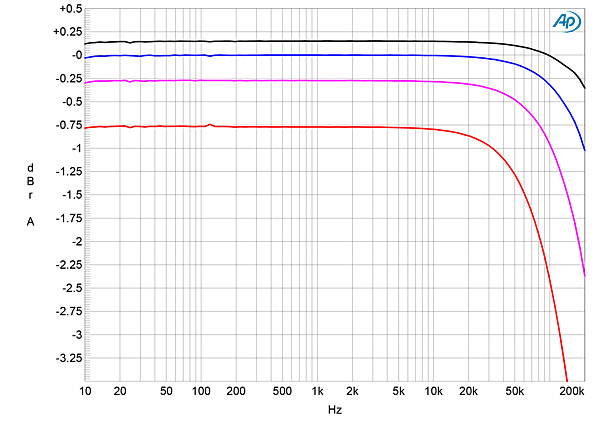
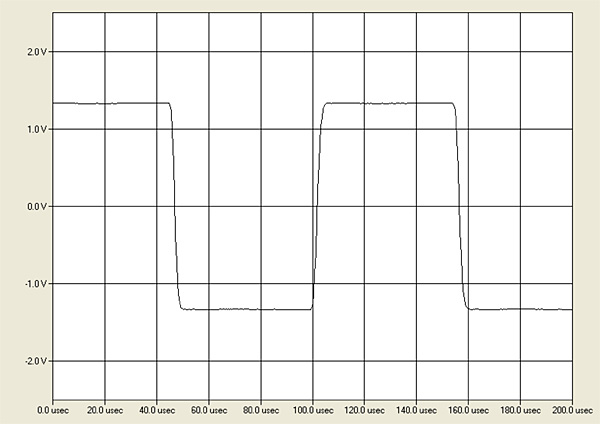
The wideband, unweighted S/N ratio, ref. 2.83V and measured with the balanced gain set to "32" and the XLR input shorted to ground, was 72.3dB, which improved to 84.7dB when the measurement bandwidth was restricted to the audioband, and to 87.2dB when A-weighted. Spectral analysis of the darTZeel's noise floor (fig.3) revealed that while the random noise was somewhat higher than I usually find, the spuriae related to the power-line frequency were all very low in level. Note, by the way, that this spectrum was taken with a 1kHz tone at 1W into 8 ohms. Referred to the NHB-468's maximum output into 8 ohms (see later), the levels of random noise components will be reduced by 26dB.
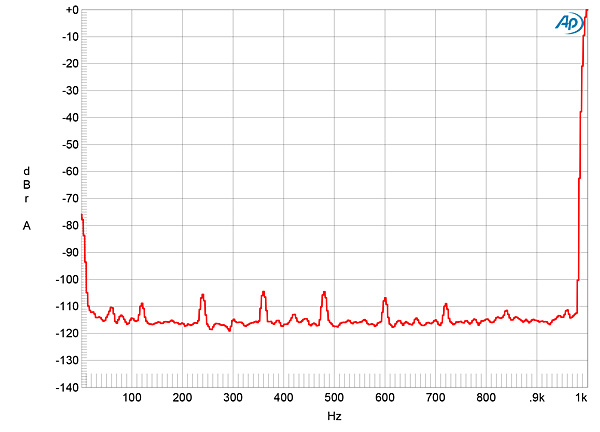
The manual specifies the darTZeel's maximum power as 475W into 8 ohms (26.8dBW), 625W into 4 ohms (25.0dBW), and 222W into 2 ohms (17.45dBW), with the latter noted as "design limited." However, Hervé noted in another email that he needed "to finalize and adjust some things in the user manual and in the technical specs, especially the power output which is a bit lower than we currently indicate on our website . . . due to the final tune-in we did before launching the production, after having already measured the beasts. I didn't want to readjust output power after our final fine tune-in (read, critical and extensive listening test sessions) since the sound would have been altered."
With that caution in mind and with "clipping" defined as when the THD+noise reaches 1%, I found that the NHB-468 clipped at 216W into 16 ohms (26.2dBW, fig.4), 398W into 8 ohms (26.0dBW, fig.5), 205W into 4 ohms (201.1dBW, fig.6), and 101W into 2 ohms (140dBW, fig.7). In each case, the amplifier's protection circuitry operated soon after the THD+N reached 1%. This amplifier offers high powers into higher impedances, but regarding the reduction in ultimate power into lower impedances, Hervé had explained in one of his emails that the 468's circuit is optimized for loads of 6 ohms, with the distribution of power "as if we would always work into the SOA (Safe Operation Area), not only for the output devices, but for the entire amplifier circuit design."
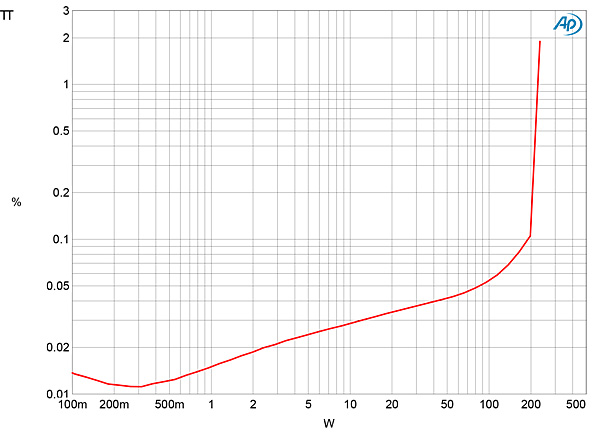
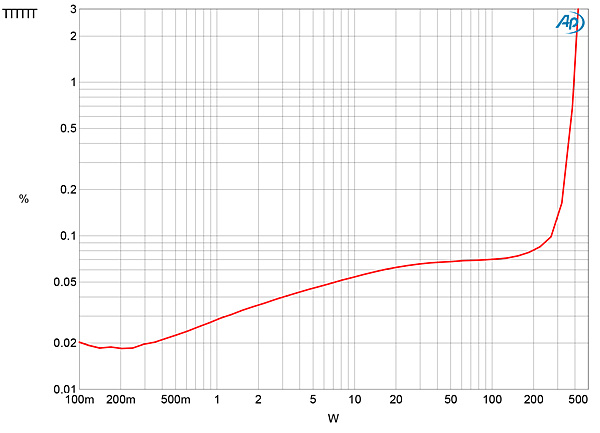
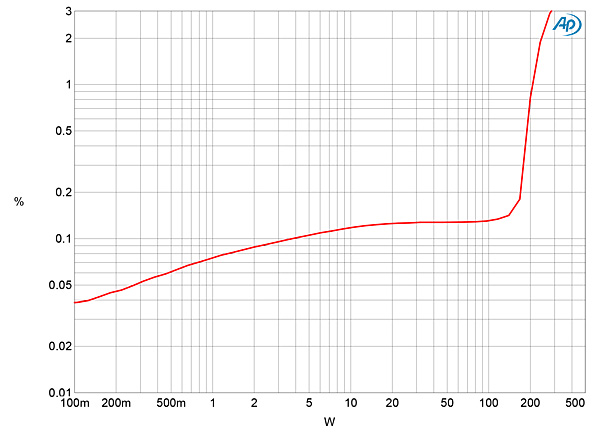
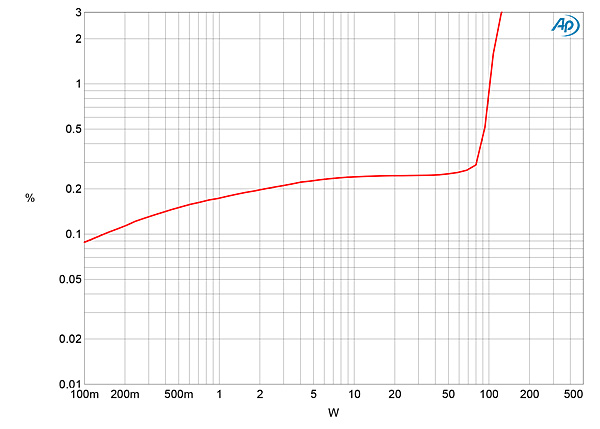
"This is also one of the reasons John will measure output powers not at all doubling when load will be halved," he wrote, "and even output power decreasing under 3 ohms."
Hervé had also predicted that, as the NHB-468 has no global negative feedback, there would be "plenty of THD for John." This can be seen at high powers into 4 ohms (fig.6) and 2 ohms (fig.7), as well as in fig.8, which shows how the darTZeel amplifier's THD+N percentage varied at 8.975V with frequency into 16, 8, 4, and 2 ohms. (This voltage is equivalent to 40W into 2 ohms, and while the NHB-468 had no problem delivering higher powers into higher impedances, I ran this test at 8.975V to make sure I was not operating the amplifier too close to clipping into 2 ohms.) More significantly, even without global negative feedback, the traces in fig.8 reveal that the NHB-468's distortion doesn't increase with frequency, which you often see with solid-state amplifiers that don't have a lot of feedback.
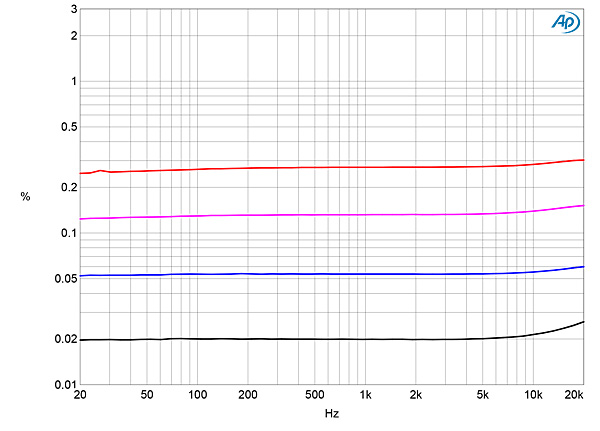
The waveform of the residual distortion and noise with a 1kHz signal (fig.9) suggests that the subjectively benign second harmonic is dominant, which was confirmed by spectral analysis (fig.10), though higher-order harmonics are present at lower levels. High-order intermodulation products with an equal mix of 19kHz and 20kHz tones at a peak level of 50W into 8 ohms were relatively low in level (fig.11), though the second-order difference product lay at –70dB (0.03%).
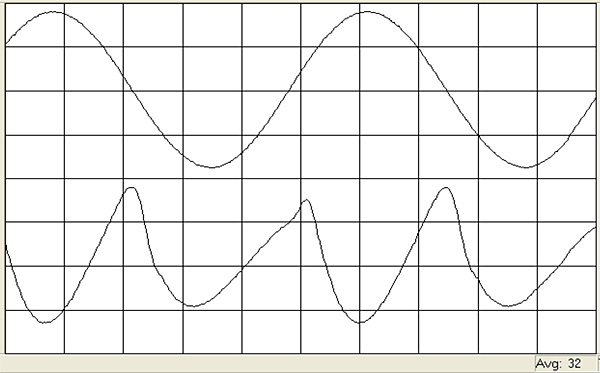
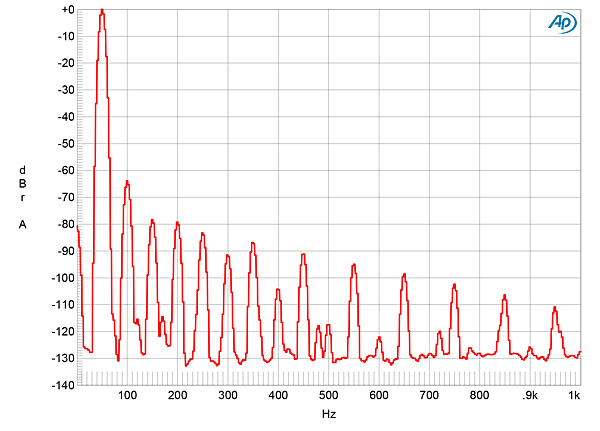
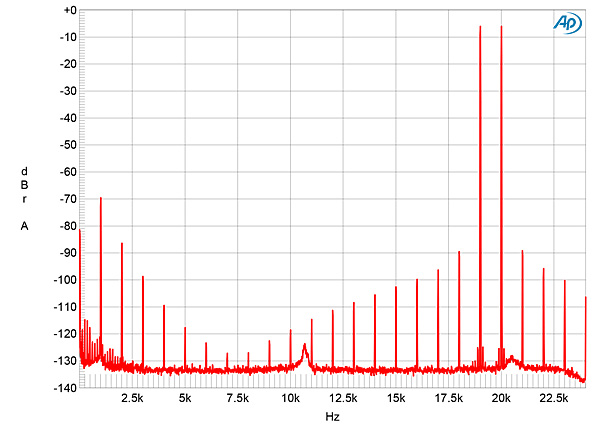
The darTZeel NHB-468's measured performance reveals it to be an intriguing design, though I couldn't find anything that would be due to the CP2C circuit. And while I was measuring the second sample, Michael Fremer found that selecting the first sample's meter options with the Menu seemed to force the amplifier to reset itself, after which gain, noise, and distortion returned to normal. Therefore, it looks as if when I selected the RCA input with the Menu then went back to the XLR input, the gain was not reset correctly, leading to the problems I found. As I found this occurred with both samples, I suspect that this must therefore be a firmware problem and could be addressed with a firmware update.—John Atkinson

Oh man are those ugly. The build quality looks incredible, but if there was an award for tackiest gaming PC, these would win it.

Spectacle de richesse :-) ........

They need to stop letting engineers design the boxes...or whatever is producing visually unappealing equipment. Like the ATC P1 amplifier. Or the Cambridge Audio Edge amplifier--please don't put the knob right smack in the middle, and don't give me those broadly rounded edges. Or those wall-eyed Chord DACs. Just give me a clean, rectangular black box and I'll be very happy. And not that eye-piercing silver stuff either...

"They need to stop letting engineers design the boxes...or whatever is producing visually unappealing equipment."
Eye of the beholder.
I'm groovin' with the Iron Man look of those amps. Pretty cool.

I like the aesthetic of "champagne" dyed anodized aluminum faceplate and rosewood panels. Sadly, the hardware that I want is not dressed like that, and form follows function in the priorities.

in Audio are all over the map: from boring to ridiculous to just plain ugly.
I actually think the Darts are beautiful.. Maybe bordering on ostentatious, but they do "look" like $175K amps!
The most prominent high end speaker design that I could not stomach be in the company of-- no matter how heavenly they may sound-- are the Wilson Speakers. Robotic, clunky, aggressive-- clearly the work of a design-impaired engineer.

Butt-ugly. Once, years ago, I heard a pair of them in a showroom. I didn't think they sounded good either.

Conclusion (or, summing up) ..... MF is gonna upgrade and buy the new darTZeel NHB-468 mono-blocks :-) .......

'cause ..... there is more there, there :-) ........

just kinda shows that his $1,000,000 system wasn't all that dam good in the first place.
Who will pay for it? we subscribers or the Manufacturer needing some Publicity? and other manufacturers.
We at General Motors regularly supply our "Advocate" Reviewers with Long Term Loaner Cars for their families, we consider the practice pervasive, we would even "help" them write their reviews.
Tony in Venice

... a Toyota made in the previous century instead of a new GM car.

Thanks for the referral, I just had a quick look at one of his "explanations" and was delighted.
His Garage is "FILLED" with hoarding Junk so he must have important opinions on things.
I Subscribed Immediately! ! Scotty will be one of my 121 YouTube Subscriptions of interesting people with things to say and the natural ability to say them. He's Loquacious
And...
You're right, GM would NEVahhhhhh let this guy near any of our New Cars or old ones if we could help it. We have a rather rich field of serious quality gaps that need forgetting.
Since we are talking about GM's embarrassing....
Adios,
Tony in Venice

(edited toward something more suitable for comparison)
Like a pair of Wavac SH-833 power amplifiers, these seem to be more focused on ostentatious conspicuous consumption rather than high performance. I would expect to find better performance at very much lower price point.
Wavac SH-833 subjective review and measured performance (MF seemed to like these too):
https://www.stereophile.com/tubepoweramps/704wavac/index.html
Performance: I want amplifiers that provide adequately clean and load invariant gain, with output capability that is well suited to the application, and with balanced inputs and internal grounding schema compliant with AES48.

That Wavac SH-833 has about 4 bits of resolution and costs $350,000 ....... This darTZeel-468 has about 11 bits resolution and costs $170,000, which is less than half the price of that Wavac amp ....... So, the darTZeel amp is a better deal :-) ..........

I have one (a power supply cap finally failed about 2 years ago, haven't had it fixed/recapped yet). Just one would be needed (it's power output was VERY conservatively rated - think Pass XA25 conservative). It would certainly win in 1 area - power output, and probably win in bass control (almost certain - it's the thing the amp does best, and does it exceptionally well). might beat it on macro-dynamics due to greater output power. would otherwise likely get its clock cleaned.

Mr. Fremer does a fine job of describing the sound of this amplifier. And I was thinking, why not just buy a pair of Wharfedale Dentons or Lintons, which to my ears are voiced to sound pretty much the same at comparatively miniscule money? I have a pair of Dentons attached to an AVM CS 2.2 all-in-one unit in a bedroom system, and the sound is so good I never feel deprived.

Never could understand the name "darTZeel".....only now, upon learning the founder's name, do I see that it is simply a re-ordering of the name "Deletraz"....
Hmm

They have all the 'Zeal' of Delétraz :-) ..........

Then you should have a room like this.
https://www acousticfields com/state-of-the-art-acoustics/

You don't recognize the color scheme?

Yes ..... Great observation ........ Those are Iron Man colors :-) ........

Crimson & Gold :-) ...........


All you need is a "Tony Stark/MCU" signature...

After all, Wilson $750,000 Loudspeakers have been featured in this Magazine.
What the hell are the Top 1% supposed to buy? , NAD you say ???
Of course, having pricy eye-candy on the Cover will sell Magazines at Book Stores. ( won't it ? ) Do these things look like something from Toys-R-us?
But still, can we expect any sort of relevance to Mainstream Stereophile Readership??
This Manufacturer murmurs about the quality of the Reviewer's Mains Voltage, I wonder why the Reviewer doesn't even have a PS Audio P20 Power Plant to insure adequate Mains Supply if trying to accurately evaluate the World's finest Amplification System. Or, why didn't the Manufacturer take steps to insure Review integrity ? ( Price no Object Reviews call for going all the way ).
Most of us will never meet anyone that "could" own this type of gear, insomuch as we are on the poor side of the Velvet Rope.
It's said to be a beautiful review. I might suggest that the Amps are as strikingly or purposely grotesque at those $750,000 Wilsons that Mr.JVS had his daringly embarassing picture taken from behind.
Maybe if I owned a Gold Toilet and a $5,000 Shower Curtain I could ....
Ok, lets make our Choice: these Amps or a Loaded Tesla S with about $60,000 Cash in the Glove Box for Impulsive Purchasing , can we have a Show of Hands?
Tony in Venice
ps. Dam good Journalism shows us how outrageous things can get.

I have zero desire to own anything Tesla, and have more disdain for Tesla products than Bose products.
Unreliability:
https://www.consumerreports.org/car-reliability-owner-satisfaction/car-reliability-issues-models-lose-cr-recommendation-car-reliability-survey/
Invasion of privacy:
https://www.forbes.com/sites/kashmirhill/2013/02/12/teslas-elon-musk-reminds-media-his-cars-can-spy-on-them/
Monitoring and data logging is so excessive that some Teslas are now bricking due to flash memory chips are failing from too many write cycles.
https://www.vice.com/en_us/article/qvgxqp/worn-out-flash-memory-is-suddenly-bricking-tesla-cars

FYI ....... Bose Model 700, Bluetooth, noise cancelling headphones ($400), were one of the 'Top-Picks' by the Sound & Vision magazine, recently :-) ........

"Of course, having pricy eye-candy on the Cover will sell Magazines at Book Stores. ( won't it ? )"
Not if people don't go to Bookstores in this age of Amazon/Kindle or aforementioned bookstores decided that said magazines weren't moving. About 15 years ago I worked at a "Borders", we had all the usual audio subjects on the Magazine racks, had to strip the covers to send back to the publishers and toss the 'zines into the dumpster most of the time. About a year ago, went to my local Barnes & Noble, they had only two "audio" titles on the racks. Used to find audio magazines in the magazine racks of supermarkets, those have been replaced with Gun magazines. I'll bet most folks reading Stereophile never encounter it in a Bookstore.
There's gonna be, say, a couple hundred people in this world who would even consider buying this ultra-pricy stuff. So I suspect it's really more about the magazine's writers getting their jollies at this point than anything else.

Schiit just released Three Important NEW Products.
Audiophile Candy for Everyman.
1.) Made in USA ,
2.) Uncompromising Good product and performance,
3.) built by a group of loyal employees,
4.) sold at fair prices.
5.) Substantial Warrantee of 5 years.
6.) Company with a History of Integrity
7.) Schiit gear retains 80% Value for eBay re-selling.
Audiophile Readership have never been taken care of like today.
Tony in Venice
ps. I've owned a range of Schiit products but I'm not "rewarded" in any way by Mr.Stoddard or the Sr. Mike.
ps. Stereophile Staff were the ones that introduced me to Schiit back in 2011.

... Schiit Sol turntables, yet?

I'm not Turntable since I stopped Selling & Servicing every Brand of TurnTable Made, in 1985ish. Esoteric Audio had a compete Turntable Lab. with Tektronix Scope and critical Mechanical instrumentation for precision Set ups. We even did Cantiliver compliance measurements, suspension evaluations and Arm Mass matching. We were and are Scientists from General Motors Research Laboratory.
I embraced digital when Tyll & Steve G introduced me to Schiit & Sennheiser at RMAF2011.
I still own a considerable collection of Vinyl that I'll eBay at some point in the future.
My Psychiatrist and I have both had our Synapses rewired for the Great Digital Sound Quality. ( just like the Pro Audio people have done 100% )
Now, a presentable Vinyl System seems to electrify the Either in the Listening Room. That is it's magical power but I'm like Jabba the Hut, it doesn't work on me, I still see it's many flaws.
Tony in Venice

Seems like Mr.Tony got tired of all the 'Stitching' and 'Non-Fill' on the vinyl records ....... (see AnalogPlanet) :-) ........

Michael claims that the mere existence of a (relatively) small number of wealthy people who purchase absurdly expensive audio equipment is a convincing reason to review this product. I’m not swayed by that argument.

If you consider the market for this sort of thing as the "the 0.1%" in wealthy parts of the world (US, Canada, The EU, Australia, parts of Asia, etc) that's conservatively about 1 billion in population total. 0.1% of that (1 billion * 0.001) is about 1 million people. cut out 90% as not interested in audio/part of same household/whatever and that's still about 100,000 people who can easily afford this and might be in the market. Who do you think buys all that silly expenisve Nordost cable (who advertise quite widely in the audio press)? same folks (I know I ain't spending 10x my system price for speaker wire lol). I assume Nordost would not continue to widely advertise if it wasn't bringing results.
Add to that number those who like to read about crazy expensive gear and you've got a big chunk of this magazine's audience.
Plus, it's an interesting and unusual circuit design which carries its own appeal.

Ridiculous.
Not because of it's aesthetics... Personally, not a fan, but just fine if you are.
Ridiculous because this over-priced Lego-blocked POS can't outperform the best amps in the world that cost from $3K to $6K each.
darTZeel should be ashamed, but, hey, I guess there are consumers that truly don't care about ultimate sound quality at these prices. Wilson Audio proves that.
This amp is a bad joke.
To it's owners, "Even though your heart is breaking, laugh, clown, laugh!" (Think of the great Daffy Duck version)

... (with the exception of KR, who uses Benchmark amps) seem to have an expressed preference for overpriced and under-performing amps?
(Wait for this month's "Listening" column from AD.)

Still waiting to see measurements on Art Dudley's reference Shindo amps.
IMHO, if Stereophile is going to recommend multiple components from a single manufacturer in class "A", regardless if it was recommended in a column, review, or Fremer's youtube channel -- They should measure the damn amp. Give me a break.
**Crickets from JA**

At the time of the original NHB-458’s release I remember Deletraz stating that he was perfectly happy with the sound of his NHB-108 stereo amplifier though constantly pressed by some well-heeled, mostly Asian, customers to make for them something ..bigger. So let’s not blame the man for trying to keep his customers satisfied. I'm not even sure that hi-end audio customers nowadays are virtually outnumbered by the almost extinct but still noisy mid-fi ones –certainly not profitwise or else manufacturers would have never turned their backs to the latter in the first place. In the meantime ordinary people are mostly content with smart/phones or active solutions and for good reasons no doubt. By the way I have only heard the CTH-8550 integrated twice and save for some wooly bass it sounded truly magnificent.

On the article's lead photo of the amp (angular view & front-face), the brass tag at lower center appears to end with "Michael Fremer" in script font (and has 4-lines engraving). In the front-face photo later in the article, the brass plate has the serial number (and 2-lines of engraving). Mr. Fremer's article states that externally the NHB-468 (review) and NHB-458 (Mr. Fremer's own amps) are very similar styling. Is the lead photo of Mr. Fremer's NHB-458, and the later photo actually the review NHB-468? Or as Mr. Fremer stated in the review, while he had no intention of purchasing the NHB-468's, was he seduced & gave-in to their enhanced performance! In any case an enjoyable read and thorough review (as always) by Mr. Fremer. Not only are my ears well trained, so are my eyes!

The photos with the ID plates are the ones Mikey tested, taken by a photographer we hired. The other photos are stock photos provided by the manufacturer. Many of the photos we publish are provided by manufacturers.
Those ID plates, by the way, were added by darTZeel before they sent them out, without our knowledge. I was concerned when I first saw the photos, since Stereophile reviewers should not agree to buy review samples before they've even been reviewed--so why was Mikey's name on them? And then I checked and found that the plate on the darTZeel stereo amp and preamp that I have in for review, from which I had never bothered to remove the blue tape covering the brass plate, have MY name on them. And I sure as heck haven't agreed to buy them and do not intend to do so: I mean no disrespect--they are very good--but I can't afford them, so they will go back when I'm done with the review. Maybe this is just something Hérvé does for a bit of fun with his review samples. Or maybe only with Stereophile. I haven't asked.
Jim Austin, Editor
Stereophile

Strange claim on the part of Dartzeel manufacturer:
Dartzeel claims:
A (Current)-Source with voltage source characteristics.
That is contradiction in terms and therefore incorrect.
A current-source with voltage-source output characteristics is a VOLTAGE SOURCE.
Good review and set of measurements.
However, simulated-speaker loading would have been appreciated.

As someone who has just suffered a second sudden hearing loss event (was it the head cold or flu shot at fault?) I'm still amused when Mikey waxes lyrical about expensive gear, must be the masochist in me. However, he's really shot himself in the foot this time, who will buy his $140K amp now the $180K amp reigns supreme? Perhaps, like us mortals, it will be confined to the bedroom/kitchen/office system, ha, ha.

which would include me I always suspect that the economies of scale will dictate that this kind of gear will, in reality,turn out to be technically unreliable and not particularly better performing, much like the venerable Delorian or the aformentioned Tesla. I recently bought a new honda civic(a two-door sport with a 6 speed stick) which has turned out to be the best handling and driving car I ever drove for less than 20K brand new. And I've owned or driven far more expensive "high performance" cars. Economy of scale is an awesome and underappreciated thing.

so this reviewer thinks a 170K amp sounds real good. Does it occur to this guy that his speakers are producing ten times more distortion(whether he thinks so or not) than this amp produces? And that this speaker distortion masks entirely any distortion produced by the amp? So if I order a 170K amp does it come with 169K in cash in the shipping box? Because that is the only way it could make sense. This kind of laughable stupidity is the reason anyone with an I.Q.over 90 finds high-end audiophiles to be idiots. Not to mention the moral obscenity of spending 170K on a stereo amp. Think about this:you could spend 5K and get a really good amp and have 165K left over to donate to fight the wildfires in australia or donate to Americas wounded warriors or to Shriners childrens hospital. Before I'm assaulted here by every audiophile let me confess; I have wasted a lot of money on audio gear.More than I care to admit.

you lame brains can't handle that some guys get to buy expensive stuff. I looked in the comments just for fun and how disturbing. I feel bad for these reviewers at Stereophile having to deal with such sour pusses

You are so correct. At this point I just laugh at the pathetics

Dartzeel’s amp circuit design optimized using active, or perfectly resistive, load, which is in audio amplification world is a little bit too optimistic. Common speakers with 2-way or 3-way crossover have non monotonic Z(f) characteristic, where impedance mag could change from couple of ohms to 10..20 ohms easily. This amp specified damping factor (DF) is 25 (@8 ohm load), which is very low, comparing to competition. Low DF increases distortions for whole amp+speaker system, and limits speaker choises for the best sound experiense. Would be interesting to see measurement results for this amp using simulated loudspeaker load, similar to https://www.stereophile.com/content/dartzeel-nhb-108-model-one-power-amplifier-measurements.

In this column, there are probably plenty of jealous, religious Americans who probably voted for a clown like Donald Trump although they should actually vote for the Communists. They find it hard to accept that many readers actually want to read about High-End products and that Michael Fremer has decades of experience and heard most of the products produced in stereo world. If just this product is beautiful or not is in the eye of the beholder. But I have no doubt that these darTZeel NHB-468 monoblock power amplifier are very good.

After reading this review, I have only one question. Would it be more embarrassing to admit that your company designed this flawed, mediocre piece of electronics, or would it be more embarrassing to admit that you were an "audiophile" that was duped into purchasing a sub-par piece of kit at an obscene price. I'll be pondering this for some time.